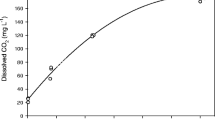Abstract
Our research objectives are to determine under what conditions microalgal-based CO2 capture from flue gases is economically attractive. Specifically, our objective here was to select microalgae that are temperature, pH and flue gas tolerant. Microalgae were grown under five different temperatures, three different pH and five different flue gas mixtures besides 100% CO2 (gas concentrations that the cells were exposed to ranged 5.7–100% CO2, 0–3504 ppm SO2, 0–328 ppm NO, and 0–126 ppm NO2). Our results indicate that the microalgal strains tested exhibit a substantial ability to withstand a wide range of temperature (54 strains tested), pH (20 strains tested) and flue gas composition (24 strains tested) likely to be encountered in cultures used for carbon sequestration from smoke stack gases. Our results indicate that microalgal photosynthesis is a limited but viable strategy for CO2 capture from flue gases produced by stationary combustion sources.
Similar content being viewed by others
References
Kadam, K. L. (2002) Environmental implications of power generation via coal-microalgae cofiring.Energy 27: 905–922.
IEA (International Energy Agency) (1998) Carbon dioxide capture from power stations. Available at http://www.ieagreen.org.uk.
Borowitzka, M. A. (1995) Microalgae as sources of pharmaceuticals and other biologically active compounds.J. Appl. Phycol. 7: 3–15.
Oswald, W. J. and C. G. Golueke (1968) Large scale production of algae. pp. 271–305. In: R. I. Mateles and S. R. Tanebaum (eds.).Single Cell Protein. MIT. Press, Cambridge, USA.
Kadam, K. L. (1997) Power plant flue gas as a source of CO2 for microalgae cultivation: Economic impact of different process options.Energy Conv. Manag. 38: S505-S510.
Sheehan, J., T. Dunahay, J. Benemann, and P. Roessler (1998)A Look Back at the U.S. Department of Energy’s Aquatic Species Program—Biodiesel from Algae. National Renewable Energy Laboratory, Golden, CO, NREL/TP-580-24190.
Hanagata, N., T. Takeuchi, Y. Fukuju, D. J. Barnes, and I. Karube (1992) Tolerance of microalgae to high CO2 and high temperature.Phytochem. 31: 3345–3348.
Yun, Y. S., S. B. Lee, J. M. Park, C. I. Lee, and J. W. Yang (1997) Carbon dioxide fixation by algal cultivation using wastewater nutrients.J. Chem. Tech. Biotechnol. 69: 451–455.
Lee, J. S., D. K. Kim, J. P. Lee, S. C. Park, J. H. Koh, H. S. Cho, and S. W. Kim (2002) Effects of SO2 and NO on growth ofChlorella sp. KR-1.Biores. Biotechnol. 82: 1–4.
Negoro, M., N. Shioji, K. Miyamoto, and Y. Miura (1991) Growth of microalgae in high CO2 gas and effects of SOx and NOx.Appl. Biochem. Biotechnol. 28–29: 877–886.
Murakami, M. and M. Ikenouchi (1997) The biological CO2 fixation and utilization by RITE (2) Screening and breeding of microalgae with high capability in fixing CO2.Energy Conv. Manag. 38: S493-S497.
Chang, E. H. and S. S. Yang (2003) Microalgae for biofixation of carbon dioxide.Bot. Bull. Acad. Sin. 44: 43–52.
Maeda, K., M. Owada, N. Kimura, K. Omata, and I. Karube (1995) CO2 fixation from the flue gas on coal-fired thermal power plant by microalgae.Energy Conv. Manag. 36: 717–720.
Sung, K. D., J. S. Lee, C. S. Shin, S. C. Park, and M. J. Choi (1999) CO2 fixation byChlorella sp. KR-1 and its cultural characteristics.Biores. Biotechnol. 68: 269–273.
Bischoff, H. W. and H. C. Bold (1963) Phycological studies. IV. Some algae from enchanted rock and related algal species. The Univ. of Texas. Publ. 6318. 95 pp.
Schreiber, U., U. Schliwa, and W. Bilger (1986) Continuous recording of photochemical and non-photochemical chlorophyll fluorescence quenching with a new type of modulation fluorometer.Photosyn. Res. 10: 51–62.
Maxwell, K. and G. N. Johnson (2000) Chlorophyll fluorescence—a practical guide.J. Exp. Bot. 51: 659–668.
Lee, J. N., J. S. Lee, C. S. Shin, S. C. Park, and S. W. Kim (2000) Methods to enhance tolerances ofChlorella KR-1 to toxic compounds in flue gas.Appl. Biochem. Biotechnol. 84–86: 329–342.
Brown, L. W. (1996) Uptake of carbon dioxide from flue gas by microalgae.Energy Conv. Manag. 37: 1363–1367.
Nagase, H., K. I. Yoshihara, K. Eguchi, Y. Yokota, R. Matsui, K. Hirata, and K. Miyamoto (1997) Characteristics of biological NOx removal from flue gas in aDunaliella tertiolecta culture system.J. Ferment. Bioeng. 83: 461–465.
Nagase, H., K. I. Yoshihara, K. Eguchi, Y. Okamoto, S. Murasaki, R. Yamashita, K. Hirata, and K. Miyamoto (2001) Uptake pathway and continuous removal of nitric oxide from flue gas using microalgae.Biochem. Eng. J. 7: 241–246.
Goldman, J. C. (1979) Outdoor algal mass cultures: I. Applications.Water Res. 13: 1–18.
Masojídek, J., G. Torzillo, M. Kobližek, J. Kopeck, P. Bernardini, A. Sacchi, and J. Komenda (1999) Photoadaptation of two members of the Chlorophyta (Scenedesmus andChlorella) in laboratory and outdoor cultures: Changes in chlorophyll fluorescence quenching and the xanthophyll cycle.Planta 209: 126–135.
Author information
Authors and Affiliations
Corresponding author
Rights and permissions
About this article
Cite this article
Olaizola, M. Microalgal removal of CO2 from flue gases: Changes in medium pH and flue gas composition do not appear to affect the photochemical yield of microalgal cultures. Biotechnol. Bioprocess Eng. 8, 360–367 (2003). https://doi.org/10.1007/BF02949280
Received:
Accepted:
Issue Date:
DOI: https://doi.org/10.1007/BF02949280



